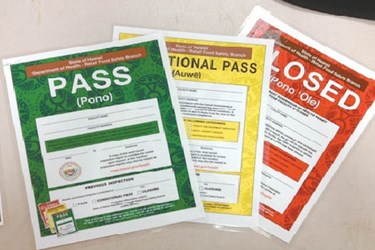Should Every State Follow Hawaii's Food Safety Lead?
By Laurel Maloy, contributing writer, Food Online

By the end of July, color-coded signs indicating a restaurant’s food-safety past will be implemented in Hawaiian eateries
After a six-month-long educational process for restaurateurs and employees, Hawaii’s residents and visitors will be able to make a more informed dining choice. Prominently placed, color-coded placards will inform prospective diners about each establishment’s food safety violations. Signed into law on Feb 24, 2014, it is hoped the placards will:
- Effectively reduce foodborne illness
- Serve to increase Hawaii’s Chapter 50 Food Establishment Regulations
- Visibly inform the public of the most current inspection results
This seems to be a very simple solution to a growing problem. What restaurant wouldn’t want to comply if it had to publicly proclaim its health inspection violations? The color-coded placards will be green, yellow, and red — these colors are also very public-friendly, as these stop light colors are easily recognized. The words “PASS,” “CONDITIONAL PASS,” and “CLOSED” will be at the top of each of the placards, along with a check box for the category of the violation(s).
Food Producers: Consumers Demand Transparency
The green and yellow placards will also have a box for the results of the previous inspection and each will be dated and signed by state inspectors. Consumers will even have the right to a copy of the most recent inspection. The expectation is that most consumers will choose to dine at restaurants with a green placard, rather than at one with a yellow or red one. The placards will be displayed prominently, in full view of the dining public, according to the findings of the most recent sanitation inspection:
Green — a green placard will indicate no violations, or not more than one major violation, observed during a routine inspection. If the violation is corrected at the time of the inspection, a green placard will be posted.
Yellow — a yellow placard will be posted if a major violation is not corrected during the inspection. It will also apply when two or more major violations are observed. An establishment will have up to 48 hours to comply, at which time a follow-up inspection will be performed. If the violations have been corrected and no other major violations are observed, the yellow placard will be replaced with a green placard.
Red — a red placard is the result of an imminent health hazard observed during an inspection and may also be posted if an establishment’s permit has been suspended. The red placard will remain in place and the facility closed, until a follow-up inspection can confirm the health hazard no longer exists. Examples of imminent health hazards include, but are not limited to:
- Severe unsanitary conditions
- Rodent infestation
- Vermin infestation
- Sewage overflow
- Lack of hot or cold running water
In addition to the placarding process, new rules have also been adopted and will go into effect at the same time. These rules include requiring annual permit renewal with the Sanitation Branch of the State of Hawaii, Department of Health. The rules also specify safer handling for ready-to-eat foods, permanently affixed thermometers in refrigerators and warmers, and education regarding consumer risk of eating raw or undercooked foods. The latter must be prominently displayed in writing, in such places as on the menu, on table tents, or on other signage within the restaurant.
CDC Studies Show Flaws In Restaurant Food Safety Systems
It is obvious this legislation could easily be adopted at the state level. Hawaii passed it and then will have full implementation within a six-month window. However, as we all know, the wheels of the federal government grind a lot more slowly. This would be win-win legislation as the restaurant owners in Hawaii strongly support this legislation and consumers will know the history of their eating destination. It makes a lot of sense. Only those with something to hide would be against it — those who take pride in the cleanliness of their restaurant will want the public to know.
